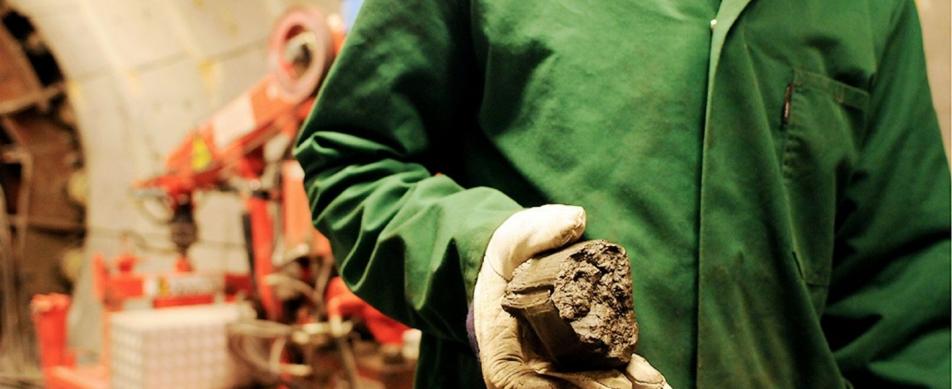For over forty years, ONDRAF/NIRAS has been studying the interactions between radioactive substances and Boom Clay as part of the development of deep disposal of high-level and/or long-lived radioactive waste.

In particular, our scientists are focusing on the migration mechanisms of these radioactive substances in clay. Our expert, Stéphane Brassinnes, explains more in this interview.
How is this disposal facility designed?
Stéphane: "Based on current knowledge, deep disposal in a stable geological layer is globally recognised as the only safe method for isolating high-level and/or long-lived radioactive waste from humans and the environment over the long term.
This waste will be placed in a facility built several hundred meters underground, in a stable geological layer known as "host rock". This is the natural barrier and also the most important, preventing or reducing the movement of radioactive substances (also known as radionuclides). Within the facility, the waste will be placed in a series of (physical) engineered barriers."

Stéphane: "These engineered barriers will remain intact for a long period, confining radionuclides and preventing their release for the first few thousand years. Over time, these barriers will degrade, allowing radionuclides and other chemical contaminants in the waste to migrate into the engineered barriers, and eventually into the natural barrier and its environment.
During this slow migration, most radionuclides lose much of their radioactivity through radioactive decay. The small amount that ends up in the biosphere after tens or hundreds of thousands of years will have a radioactivity level below the acceptable limits set by the safety authorities."
 Clay
Clay
What radionuclide transport mechanisms are we studying in the context of this disposal?
Stéphane: "For over forty years, we have been conducting extensive research on the behaviour and evolution of this disposal system to enable a robust analysis of its long-term safety. Our Research, Development and Demonstration (RD&D) programme focuses primarily on poorly indurated clay as a potential host rock. Studies and experiments are conducted in both surface laboratories, on clay cores and in the HADES underground laboratory built at a depth of 225 meters in Mol, in a layer of poorly indurated clay known as "Boom Clay".
Due to its mineralogical and chemical properties, Boom Clay is highly impermeable and has a high retention capacity for many radionuclides and chemical contaminants. It is therefore well-suited to delaying their migration into the environment, and thus plays an essential role in the long-term safety of deep disposal.
Our current research examines the migration mechanisms of these radionuclides in clay. By studying these mechanisms, we can assess the evolution of the disposal facility and the geological environment in which it is located."
Our studies focus on three key mechanisms
 The HADES underground laboratory built at a depth of 225 meters in Mol
The HADES underground laboratory built at a depth of 225 meters in Mol
Transport of radionuclides in water
Stéphane: "Clays are like millefeuille pastries: they are made up of very thin layers between which are chemical elements that ensure coherence between these layers and water. This is what we call pore water. Once the engineered barriers have degraded and the clay takes over, the radionuclides will come into contact with this pore water and diffuse into it. As this pore water hardly moves, radionuclide transport will be extremely slow.
We are studying this transport using both small-scale laboratory experiments and large-scale experiments in the HADES underground laboratory. These experiments involve injecting radioactive tracers into the clay and tracking their very slow migration."
Solubility speciation
Stéphane: "Our solubility speciation studies aim to identify the dominant chemical species of the radionuclide ("speciation") in this pore water. Will we observe a precipitate, colloidal suspensions or just the dissolved element? And at what concentrations? This information is essential because, on the one hand, the chemical species of the radionuclide determine how it migrates in the clay. On the other hand, the higher the concentration of a radionuclide in water, the greater its release from the disposal system over time.
These studies provide us with an inventory of the various chemical species of radionuclides that will end up in the clay's pore water, enabling us to assess the primary transport mechanisms of these radionuclides."
Sorption
Stéphane: "Clay layers have electrically charged surfaces to which most radionuclides will bind. This is the sorption mechanism of radionuclides that we are also studying. The sorption of radionuclides facilitates their radioactive decay in the host rock, thus limiting their radiological impact during their slow migration.
The pore water in poorly indurated clays, especially Boom Clay, can contain large quantities of organic molecules (remnants of plants and animals left over from clay sedimentation in the marine environment). Some radionuclides have a very strong affinity for these molecules, which reduces their chemical sorption in the clay and encourages their release. We are therefore investigating the interactions between these organic molecules and radionuclides in order to refine our understanding of sorption mechanisms."


